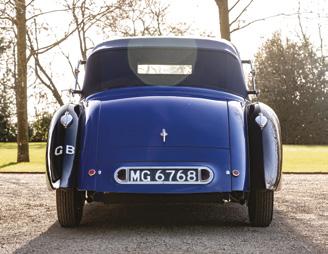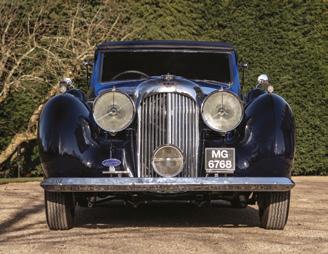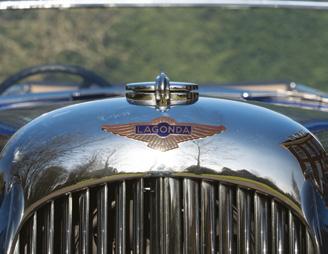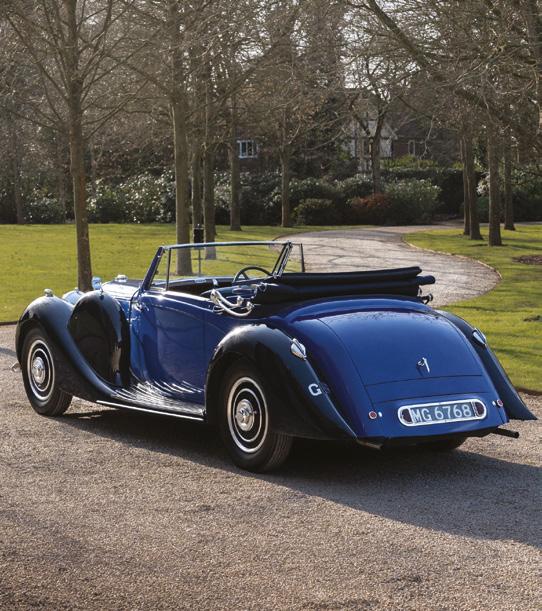
5 minute read
1939 Lagonda V12 Drophead Coupe
Estimate: £250,000 - £300,000*
Reg No: MG 6768 Chassis No: 14092 MOT: Exempt
‘Of the half-dozen patrician motor cars still remaining on the world market, none ever inherited such a rich patrimony of design as the 12-cylinder Lagonda . . . It is a newborn car, unrelated to any yet on the road - here or on the Continent . . . Such is the 12-cylinder Lagonda - a car destined to rank from now on, among the greater names in motoring history’. (Lagonda Press Release, August 1937)
The Motorcar offered:
According to information kindly supplied by the Hon. Registrar of The Lagonda Club Mr Arnold Davey, chassis number 14092 was first registered on June 12th 1939 to a Mr A.C.W. Norman of Montague St, London W1. A factory-bodied Drophead Coupe built on the short (10ft 4in) wheelbase, its guarantee was issued three days later. Fitted like many of its siblings with a replacement Sanction 2 engine under warranty (V12 151 being swapped for V12 59), ‘MG 6768’ was purchased by its second keeper, a Mr Withair of Cheyne Place, London SW3 in November 1945. Looked after by Davies Motors of Staines until 1952 (the same year that Mr Davies - a former Lagonda service manager - curtailed his role as the factory’s semi-official maintenance depot for pre-war cars), the V12 subsequently migrated to Bognor Regis (Mr Dewhurst) and Middleton-on-Sea (Mr Sanderson) before being bought by the Hollinshead family who barn stored it for forty years.
Still covered in protective wax when purchased by Alfred Hill MBE via our July 2006 Buxton auction, the Lagonda soon found itself being completely disassembled down to the bare chassis for the first time since leaving the Staines factory. Stripped to a bare block, the engine was thoroughly overhauled with new parts including: crankshaft, con-rods, forged pistons, camshafts (plus associated bearings), valves / valve springs, timing chains, bearings, pulleys and various skew gears etc. The clutch was renewed and the G10 four-speed manual gearbox rejuvenated with fresh bearings and sundry synchro hubs. The suspension was reconditioned with new bushes and attention paid to the torsion bars, rear leaf springs and dampers. The brake drums were overhauled with new linings and the back plates refurbished. A new wiring loom was installed and the fuel system gone through. Ancillaries such as the starter motor, dynamo, ceramic seal water pump and carburettors were restored. Gaining a new crown wheel and pinion and differential bearings courtesy of LMB Racing, the Lagonda had its radiator and wheels / hubs reconditioned by CPA Services and Richard Bros respectively. Numerous photos on file also show the ash frame being repaired / remade and the aluminium bodywork restored to its ex-Works condition.
Retrimmed in Dark Blue leather with a matching mohair hood by J. Krych, the interior also gained a European walnut dashboard and door cappings. Following a bare metal respray, the original Drophead Coupe body had its brightwork refinished by S&T Electro-Plate. Sadly, Mr Hill died before ‘MG 6768’ had been properly run-in or debugged. Thankfully, the vendor whose garage has hosted various important W.O. Bentleys, Bugattis and front-engined Grand Prix cars proved an ideal new owner. Discovering that a huge amount of man hours and money had gone into the project, he set about fine tuning the result. Thus, the ingenious mechanism which secures the door in two planes is fully functional, the ‘disappearing’ rear luggage rack works as it should and literally every ‘nut and bolt’ underneath has been checked and tightened as necessary. A seasoned racer, the vendor is a firm believer in preparation and even a cursory examination shows that the Lagonda has been suitably gone through and set-up. He has even added mesh guards to the underside of the wings to prevent stones flung up by the tyres causing any damage.
Starting readily upon inspection, idling happily and accelerating in a decidedly postWW2 fashion, the V12 remains every bit as impressive as it must have done eightyodd years ago. Having covered a mere 400 miles or so since its comprehensive refurbishment, the Lagonda still requires running-in (with the brakes yet to ‘bed in’ fully etc). The clutch actuated chassis lubrication system has been supplanted by a series of grease nipples and the hydraulic in-built jacks disabled (though, various correct-type jacks come with the car). Collectors have traditionally been wary of W.O. Bentley’s masterpiece but we believe ‘MG 6768’ to be among the very best examples available. Indeed, the seller’s mechanic has told us that he is happy to continue servicing / maintaining the V12 for a new owner. Drawing on the expertise of Bishopgray, LMB Racing and Mel Cranmer, the Drophead Coupe is a singularly imposing and impressive machine. Decidedly undervalued when compared to its Bugatti Type 57 and Mercedes-Benz 540K counterparts, the Lagonda is offered for sale with a continuation buff logbook, three files of invoices and numerous photographs. A jewel for any collection, we estimate that the guide price would be met or even exceeded if a marque specialist were to undertake a similarly exacting restoration today.
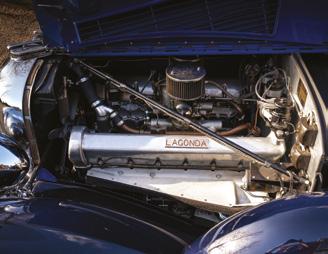

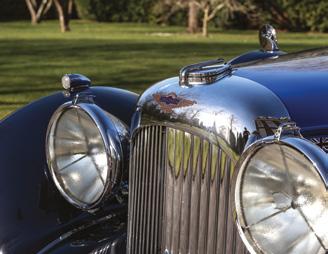
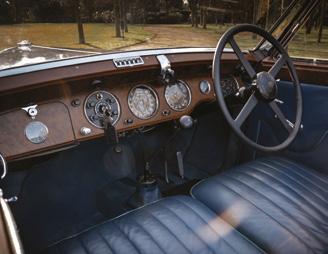
Model Background:
‘In making an evaluation of the better British cars, the Lagonda V12 certainly must be considered an excellent design and one that contributed to raising the state of the art - not forgetting, of course, that it probably should be considered W O Bentley’s masterpiece’. (Road & Track, October 1978).
The most technologically advanced motorcar to come out of Britain pre-WW2, the Lagonda V12 had few international peers. Bugatti’s Type 57 may have boasted a similarly exotic overhead camshaft powerplant but its chassis layout was positively archaic by comparison. MercedesBenz’s 540K could match the British car’s power output but only when its refinement-compromising supercharger was engaged, while Hispano-Suiza’s J12 needed over twice the cubic capacity to develop an extra forty horsepower! A landmark design, the Lagonda will forever be notable as the world’s first production car to feature an overhead camshaft V12 engine.
Debuting in prototype guise at the October 1936 Olympia Motor Show (but not officially launched for another year), the Lagonda V12 was engineered by a crack team of ex-Rolls-Royce employees including W.O. Bentley, Stuart Tresillian and Charles Sewell. A ‘clean sheet’ design that aimed to marry limousine refinement to sportscar performance, it was based around a substantial cruciformbraced box-section chassis. Boasting sophisticated unequal-length wishbone independent front suspension actuated via unusually long torsion bars and special shackle pins that helped obviate side thrust on its semi-elliptic rear leaf-springs, the newcomer also incorporated a Marles steering box, Salisbury hypoid rear axle and Lockheed hydraulic drum brakes. Singularly advanced, the model’s aero-engine inspired 60? V12 featured overhead camshafts (one per bank), twin SU carburettors, a combined duplex-chain / gear-driven timing system and Lanchester-type vibration damper. Displacing 4480cc (bore 75mm x stroke 84.5 mm) the unit was quoted as developing 180hp @ 5,500rpm. Available in 10’4”, 11’0” and 11’6” wheelbase lengths, the Lagonda flagship was among the fastest cars of its generation. Though, the provision of a centre-change four-speed manual gearbox (with synchromesh on the top three ratios) and conventional pedal layout made it surprisingly easy to drive.
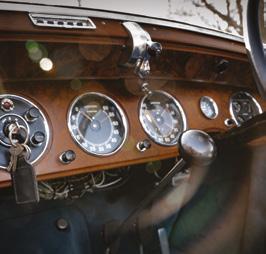
Beguiled by in-house stylist Frank Feeley’s marvellous creations which seemed to capture the very spirit of the age, most customers opted for factory coachwork. Indeed, such was the flamboyance of Feeley’s designs - which looked as if they could have sprung from the drawing boards of Jacques Saoutchik or Figoni & Falaschi - that most external coachbuilders produced bodies with altogether more conservative lines. Some eighty years on and the market has shown a marked preference for factory coachwork. Of the 190 Lagonda V12s produced between 1938 and 1940, a mere 100 are thought to have survived to the present day (though, comparatively few of those still retain their original coachwork).

